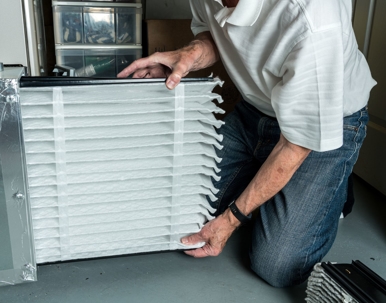Has your heater stopped working? Before you pick up the phone to call a technician, you might be able to solve your home’s heating problem on your own. It might be as simple as flipping a switch.
If your heater isn’t running, try the following troubleshooting steps.
1. Check for an unresponsive thermostat.
If your thermostat doesn’t work, neither will your heater. If your thermostat’s display is blank or if it’s acting strangely, try changing the batteries. A blank, hardwired thermostat could also mean that the electrical circuit it’s on isn’t receiving power, so check your circuit breaker panel for a tripped breaker.
2. Make sure your thermostat’s settings are correct.
It’s always a good idea to double-check your thermostat’s settings, especially if you have kids in the house who may have fiddled with them.
There are a couple of things to keep in mind when it comes to thermostat settings:
- If your thermostat is set to “on,” then your system’s fan will continue to circulate air through your home even if it isn’t heating the air. This can help your home achieve a more even temperature, but after a while, it may feel like cold or room temperature air is coming out of your vents.
- If you only want your system to run while it’s heating air, then set the thermostat to “auto.”
3. See if your system tripped a circuit breaker.
Furnaces require electricity to ignite—even models that use oil and natural gas. If your furnace isn’t getting electricity (due to a tripped circuit breaker, for instance), then the flame can’t light. Check your home’s circuit breaker panel for a tripped switch and flip it back to the “on” position. If you own a heat pump, it’s also possible that the outdoor unit tripped a circuit breaker, so check for that as well.
4. Replace the air filter, or try a filter with a lower efficiency rating.
A dust-caked air filter will obstruct airflow through your heating system. Eventually, this can cause the equipment to overheat and shut down. Most air filters should be replaced within 90 days, although if you’re using your system daily, you may need to replace your filter much sooner.
If you’ve recently placed a new air filter into your heating system, the problem could be the filter’s efficiency rating. The higher the rating, the higher the level of filtration. While this may make you want to buy the highest rating possible, your particular HVAC system may not be able to handle a filter that restrictive. For most systems, we recommend a filter with a minimum MERV 8 rating, but before buying anything higher than a MERV 12, check the owner’s manual for your particular system.
5. Make sure your furnace’s door is closed securely.
If you’ve tried all the steps above, and your furnace still refuses to run, double-check the furnace door. Just to be sure, open the door and close it until it’s snugly in place. While this may seem counterintuitive, many furnaces won’t run unless the unit’s door is securely closed as a safety precaution.
6. Make sure your furnace’s power switch is turned on.
Next to your furnace, there should be something that looks like a light switch. This is your furnace’s power switch. If your heater was recently serviced, the tech might have forgotten to turn this switch back on, so double-check that it’s in the “on” position.
Heat pumps have an additional power switch next to the condenser (outdoor unit). Occasionally, a technician may forget to turn the power back on after servicing the unit, so if you own a heat pump, be sure to check this switch as well. It will be protected in a metallic box on the wall beside the outdoor unit.
7. Make sure your furnace is getting gas.
A gas-burning furnace gets natural gas from a gas line. On this line, typically right next to the furnace, there’s a valve that controls the flow of gas to the heating equipment. Sometimes people will shut this valve off when winter is over as a safety precaution. It’s also standard for technicians to turn it off when performing furnace maintenance.
Just in case the valve wasn’t turned back on, check the position of the lever. The valve’s lever should be parallel to the gas pipe to allow gas to flow freely. If the lever is forming a “T” shape with the gas pipe, then the valve is off. Simply turn the lever until it’s in the “open” position.
Still having trouble with your heater?
Contact Rescue Air and Plumbing 24/7 for fast and fair heating repairs throughout Dallas: (972) 201-3253.

